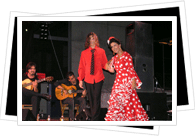Flamenco History
 Flamenco is a performing art comprised of 3 main elements: "el cante" (singing), "el baile" (dancing) and "el toque" (guitar playing). Its origins can be traced to the gypsies of southern Spain, and purists still believe that they are the only ones that can truly understand and create flamenco. Nevertheless, flamenco's influences reach as far east as the gypsies themselves - India, Hungary and Romania - and you can find traces of Arab, Jewish and popular Spanish song from the Iberian Peninsula as well.
Flamenco is a performing art comprised of 3 main elements: "el cante" (singing), "el baile" (dancing) and "el toque" (guitar playing). Its origins can be traced to the gypsies of southern Spain, and purists still believe that they are the only ones that can truly understand and create flamenco. Nevertheless, flamenco's influences reach as far east as the gypsies themselves - India, Hungary and Romania - and you can find traces of Arab, Jewish and popular Spanish song from the Iberian Peninsula as well.
For centuries, flamenco history was defined by a “hermetic” period, unknown to the outside world and practiced only within gypsy communities. "El cante" (singing) came first, expressing the plight and tribulations of the marginalized gypsy community through the eternal themes of sorrow, suffering, and loneliness. Even love and joy have a bitter tinge when performed; flamenco is, above all, an art of the oppressed. Dance and guitar were later integrated and organized into shows for “cafés cantantes” in the 19th century.
As popularity grew, the art form spread and became more and more renowned throughout Spain and the world. A natural evolution progressed: with greater popularity came greater structure, dance schools, corruption of the “pure” form and commercialization... and beyond.
